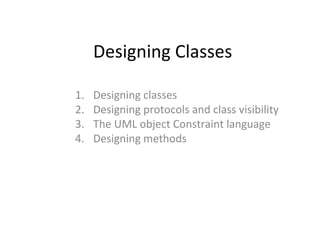
Unit 4 designing classes
- 1. Designing Classes 1. Designing classes 2. Designing protocols and class visibility 3. The UML object Constraint language 4. Designing methods
- 2. Introduction • Designer has to know – Specification of the class – interaction of that class with other classes
- 3. Object oriented design philosophy • Designing class with reusability in mind -> more gain in productivity and reduce the time for developing new application
- 4. UML Object Constraint Language(OCL) • The rules and semantics of UML are expressed using OCL • OCL – Specification language – Uses simple logic to specify the properties of the system • UML modeling constructs requires expression. some example as follow – Item.selector • Item -> object • Selector -> attribute • Ex : kathir.regno – Item.selextor[qualifier-value] • Qualifier is uesd to select related values • Ex: – Kathir.phone[2] – Set->select ( Boolean expression) • Company.employee->salary>20000
- 5. Designing classes : process • Apply design axioms to design calsses , their atribute, methods and association , structures, amd protocols – Refine and complete the static uml class diagrams by adding details to that design • Refine attribute • Design methods and protocols – Uses uml activity diagram to represent algorithm • Refine the association bw classes • Refine class hierarchy and design with inheritance – Iterate and refine
- 6. Class visibility: desiging well defined public , private and protected protocols • 2 problems in designing methods or attributes of class – Protocol or interface to the class operation and its visibility – How it is implemented • Protocol layers – Private protocol – Protected protocol – Public protocol
- 7. Internal layer • Defines the implementation of the object • Apply axioms and corollaries ( corollary 1) to decide what to private • Private protocol – Includes messages that should not be sent from other objects – Accessible to only operations of that class • Protected protocol – Methods and attributes can be used by class itself or its subclass
- 8. External layer • Design the functionality of the object • Public protocol – Defined to pass message bw associated classes – Interpretation and implementation of each message is up to the individual classes
- 9. Encapsulation leakage • lack of well designed protocol leads to this problem • Encapsulation leakage occurs when details about classes internal implementation are disclosed through the interface
- 10. Refining attribute • Attribute – Represents the state of the object • Analysis phase -> name of the attribute is sufficient • Design phase -> detailed information must be added • Attribute types – Single valued attribute • Ex: dob of the student – Multiplicity or multivalue attribute • Subjects handled by the staff – Reference to another object or instance connection • Person hold the account
- 11. UML attribute presentation • OCL is used in the design phase to define the class attributes • Attribute presentation – Visibility name : type-expression = initial-value – Visibility • Public visibility : + • Protected visibility : # • Private visibility : - – Type expression • Language dependent specification of the type – Initial value • Language dependent expression for the initial value
- 12. Designing methods and protocols • Specifying the algorithm for methods – By using formal structure (ex uml activity diag) with OCL • Types of methods – Constructor – Destructor – Conversion method – Copy method – Attribute set – Attribute get – IO methods – Domain specific
- 13. Design issues : avoiding pitfalls • Better to have Large set of simple classes than few large , complex classes – Initially class might be too big – Apply design axioms and corollary • to reduce the size • Improve reusability
- 14. UML Operation presentation • Visibility name: (Parameter list ) : return-type-expression – Visibility • Public visibility : + • Protected visibility : # • Private visibility : - – Name • Name of the operation – Parameter list • List of parameters each specified by – Name : type expression = default value – Return type expression – Ex: • + withdraw(amount:type):
- 15. Packaging and managing classes